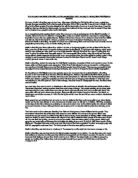Perhaps the most significant event in King’s days before he was known as the leader of black civil rights movement was the arresting of Rosa Parks, who refused to give up her seat on a bus to a white man. After the arrest, king and his friends organised one of the most famous protest boycotts ever. They decided that black people in motgomery would refuse to use the busses until passengers were integrated. For 13 months the 17,000 black citezens of Motgomery walked to work or got lifts to other protestors to where they needed to go. With such power in numbers united there would definitely be serious consequences if the black people could work as a team. To maintain such large numbers of people King’s morale boosting and leadership qualities are unquestionable, as are his protest tactics.
This action had such an enormous affect on the bus companies that it seemed they had no choice but to integrate the transport. The Supreme Court still had to force the bus companies to integrate fully, though. This was the first milestone for black anti-violent proest and showed black people what they could achieve if they persisted. The success of this was a real blow to the egos of the racists of America. The irony of the protest must have angered them, which may have been what king wanted as a side effect. If the white people are angered it is easier to show the world how the black people are innocent and the white people are the violent oppressive ones. This situation would add to the success of King’s policy of non-violent action by showing that when black people united they could achieve huge things like this.
After the success of this King became a founding member of the SCLC, which was an organisation committed to using non-violence in the struggle to end racial discrimination. The motto of the SCLC was “not one hair on one head of any person should be harmed.” The SCLC was significant and boosted the chance of success because the black church, which was very powerful, especially in the south, was now involved fully in the struggle.
A group of students who had read King’s work decided to take action themselves by staging the first demonstrative sit in. The students who followed Kings work did not hit back when attacked, and the sit-ins popularity grew and grew to further cities and oppressive regimes. The sit-ins were successful against segregation in parks swimming pools, theatres library’s museums and beaches. The success of these sit-ins was enormous and aided by King’s morale boosting speeches and advocation of non-violence.
A less successful campaign was to end segregation at lunch counters in Alabama in 1963. Police turned dogs and fire hoses on the demonstraters, King and his supporters were arrested, but remained non-violent.
One of the most famous marches and speeches ever was the march on Washington and kings ‘I have a dream’ speech. The march was for Jobs and Freedsom on the 28th of August 1963 where estimates on the numbers of people who attended range from 250,000 to 400,000. This march got the most publicity of any of King’s Triumphs and gained publicity for his cause. The amount of publicity it got was mostly due to King and because it got so much publicity and was peaceful, this was hugely successful.
One criticism that often plagued King was the notion that he was provoking the whites and causing trouble just to get publicity and show the state of affairs. I would tend to say I agree with this view, but wouldn’t criticise him for it, King never expected a march to be peaceful if the racist white people had anything to do with it. The fact remains, however, that the black people were non-violent, they did not cause bodily harm to anyone and did not verbaly provoke the whites. For the purpose of answering this question I would say that it is classified as non-violent direct action so this method was extremely successful.
Another criticism levelled at King was that, should King never have gotten involved, would the civil rights movement have had the same impact on society?
I would have to say no, King was such an amzing leader, speaker and overall morale booster that even if non-violent protests have taken place, they wouldn’t last for 13 months like the bus boycott. Kings stratagies were ingenius and his publicity for the cause was huge even though he was criticised for this also, by blacks mostly. There is one thing that can never be questioned about king and that is his dedication to the cause. King started the black civil rights movement, he kept pushing and pushing for equality in everything and didn’t simply stop when black people earnt the right to vote. He kept pushing for equal rights for everyone, litterally, until the day he died for his cause, in Memphis Tennesee, March 1968.







